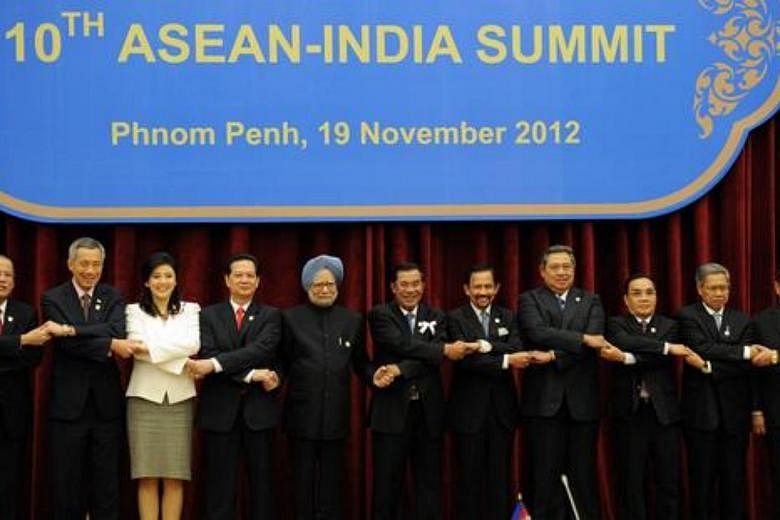India's Republic Day, celebrated on Jan 26, is the occasion that New Delhi picks to showcase itself to the world. With the country's love for pomp and ceremony, the parades tend to be dazzling spectacles. Massed bands, marching platoons of Gurkhas and Sikh soldiers, heavy armour and the latest missiles stream in a procession down the former King's Way, sharing space with floats from various Indian states.
Often, they carry a not-too-subtle message. A tableau from the eastern state of Arunachal Pradesh, a region claimed in its entirety by China, is a barely concealed signal to Beijing of who has control. Likewise, the chief guest is carefully chosen: In 1994, when India sought to build its Look East policy, it invited then Singapore Prime Minister Goh Chok Tong. Mr Goh's pre-visit words of intending to "spark a mild India fever" resonated around the world and set the stage for what would eventually turn out to be a tight relationship.
Now, as its Look East policy morphs into what Prime Minister Narendra Modi calls an "Act East Policy", India is poised to make another hugely symbolic gesture - inviting the heads of state or government of all 10 Asean member states to the January event.
In typical Modi fashion, the gesture is a grand one. And filled with meaning, more so since it comes at a time of tense ties with China and New Delhi's steadily advancing strategic ties with Japan and Vietnam, both with formidable military strength. Indeed, those in South-east Asia in the habit of peering at crystal balls may ponder whether the Indian army's action in Bhutan - when it went to the aid of the Royal Bhutanese Army to block Chinese soldiers from building a service road in territory claimed by Thimphu - is worth extrapolating in a future context involving the region. India's southernmost point is in the Nicobar islands of the Andaman Sea, so close to Indonesia's Banda Aceh on Sumatra island that India is virtually a South-east Asian state as well.
What's more, India has latterly embarked upon a policy of beefing up its strategic presence in the Andamans and, in a first for itself, indicated it is open to allowing in a foreign presence on the islands by discussing a small power project with Japan, which had control of the area during World War II.
The Indian Navy is also to start continuous patrolling of the area, indicative of heightened security sensitivities. In an earlier era, plans for the Indian Air Force to station a squadron of Jaguar fighter bombers on the islands were shelved so as not to alarm Asean states. Things have clearly changed since China altered the status quo with its assertive policy in the South China Sea.
If evidence were needed about India's ability to project power in South-east Asia, it became available more than a decade ago when the Indian Air Force and Navy organised a prompt and massive rendering of humanitarian aid to Indonesia, Sri Lanka and the Maldives in the wake of the tsunami that struck in 2004.
"Asean has a natural interest in the growing ties between India and Japan," Indian Foreign Secretary S. Jaishankar said in Singapore this week. "Gradually and steadily, Japan has emerged as a special strategic partner with whom India increasingly shares a global agenda."
He also specifically mentioned Vietnam, another Asean state that has a difficult relationship with China, with which India's strategic ties are growing "ever stronger".
Clearly, ties between India and Asean have come a long way since 1992, the year the grouping accepted the South Asian giant as a sectoral dialogue partner. Four years later, this was upgraded to full dialogue partnership status and, in 2012, to a "strategic" partnership. Currently, there are 30 dialogue mechanisms between India and Asean, including an annual summit and seven ministerial dialogues.
Ties with individual Asean states are also deepening by the day. Meanwhile, issues beyond - China and the United States being two - are also taking on salience in the relationship. "It is important that India and Asean have honest conversations on the big issues of the day," Dr Jaishankar said, sketching out areas that need focused deliberation. These, he said, cover connectivity, maritime security, terrorism, economic globalisation and a security architecture based on shared values.
India's top Foreign Ministry official is not wrong, of course. And he is talking from his nation's viewpoint. From an Asean viewpoint, though, he ought to take his cue from the recent speech his foreign minister gave at the 9th Delhi Dialogue with Asean.
Mrs Sushma Swaraj described the future focus of India-Asean cooperation in terms of three Cs - Commerce, Connectivity and Culture. In prioritising commerce, Mrs Swaraj hit the right button.
For much of South-east Asia, trade is the lifeline. A crimping of export markets hurts heavily - see how quickly the Philippines came to Beijing's heel after China leaned on its fruit shipments - because it hurts ordinary people's lives. More than all the warships that could potentially be sailed into the South China Sea or the foreign direct investments into mines and factories, access to markets is what touches the ground most.
Yet, on openness to trade, India's record is less than stellar. While there has been an uptick in the Asean-India trade relationship over the past year, this comes on the back of two years of trade regression. At US$70 billion (S$96 billion), two-way trade is not only way short of potential, but it is also dismally short of the US$100 billion target for 2015 India had itself set with Asean.
What's worse is that India has been taking a singularly unhelpful attitude on negotiating the Regional Comprehensive Economic Partnership (RCEP), an Asean-driven initiative to build a regional trading bloc between Asean and the six nations with which it has existing free trade agreements. Its negotiators change too frequently and, when they sit down for talks, voice reluctance to give equal market access to all RCEP members. When prolonged negotiations lead to an agreement to consider a unified structure for all, they seek to add a clause of "with minimal deviation" for some economies such as China, New Zealand and Australia. Behind the scenes, some Asean states suspect it of lobbying large economies such as Indonesia to agree only to 80 per cent or so goods coverage for tariff reductions, whereas many Asean states seek a higher threshold.
Indian negotiators also press the point that their economy's strengths and competitive advantage lie in the service sector. Consequently, they demand freer access for its professionals and services firms to enter partners' markets. While that is not an unreasonable demand, India should know that even in the World Trade Organisation, trade in goods and services are separate issues and not negotiated in tandem. Besides, unlike trade, almost every service you can think of - the medical, legal and accountancy professions to name just three - tends to have individual regulators, making this a far more onerous task than a simple goods agreement.
This is where New Delhi needs to take a strategic view. Unequivocal endorsement of a high-quality RCEP is as much a political statement as an economic one. It will signal a level of confidence in its own destiny and ability to compete that few other gestures can match. New Delhi should be aware it is not the only nation to have a trade deficit with China. Every Asean country is in the same situation but their instinct is not to build walls around them.
Already, there are murmurs in some quarters of seeking a "Minus One" solution if Indian recalcitrance persists - essentially seeking to proceed without India, and giving it the option of joining RCEP at a future date. That would be a pity.
The next round of RCEP talks is to be held later this month in Hyderabad. It is a good occasion for New Delhi to take the necessary steps to make speedier economic integration a tangible good for the more than 600 million who call South-east Asia home. It would also make the Asean heads of state travelling for India's Republic Day feel a lot more welcome.


